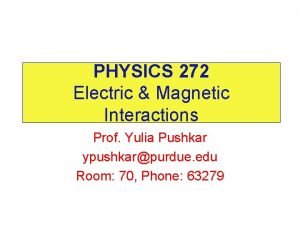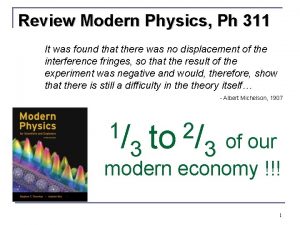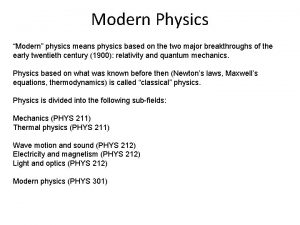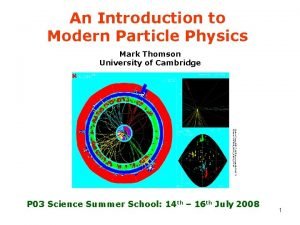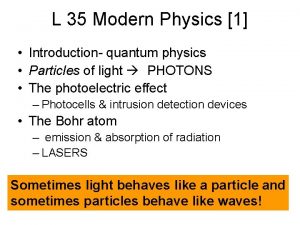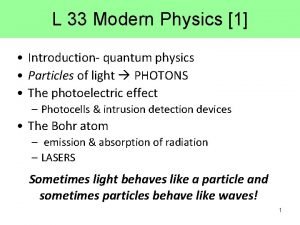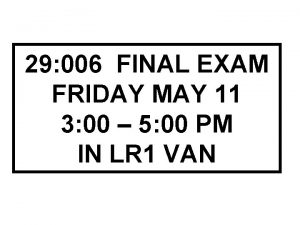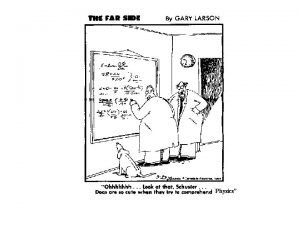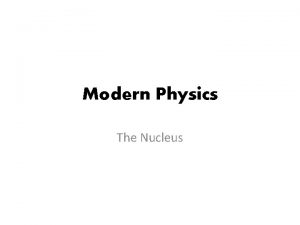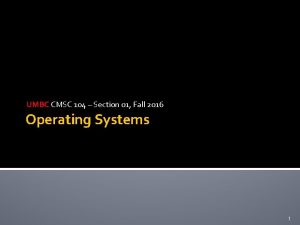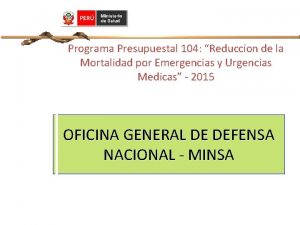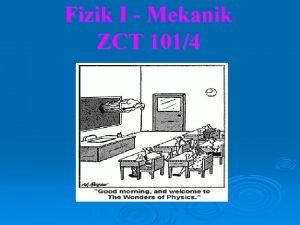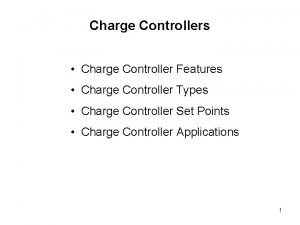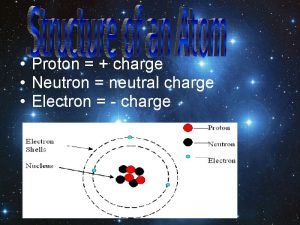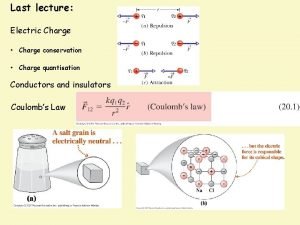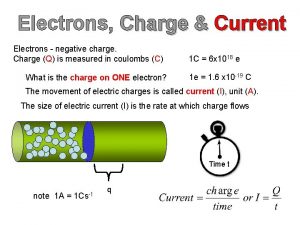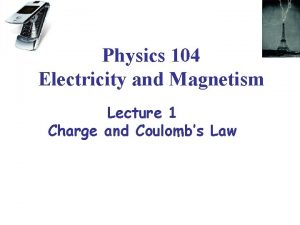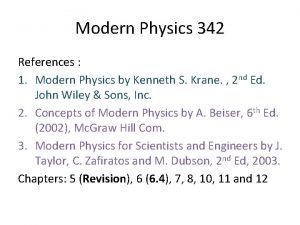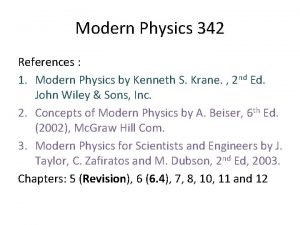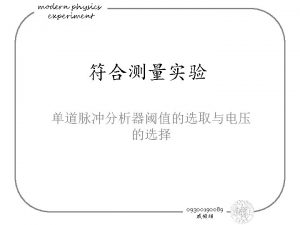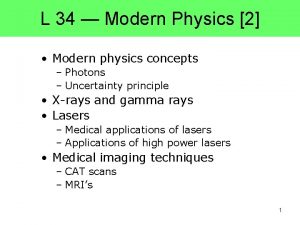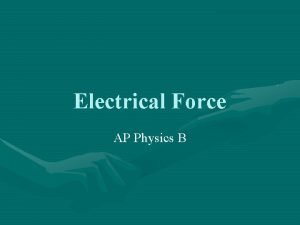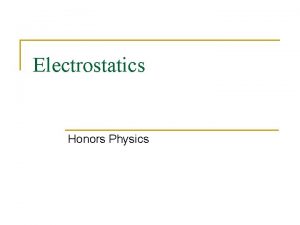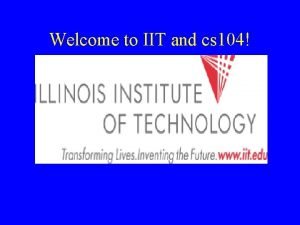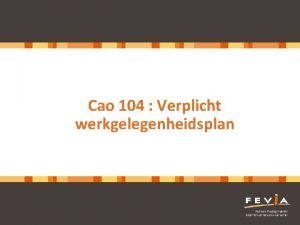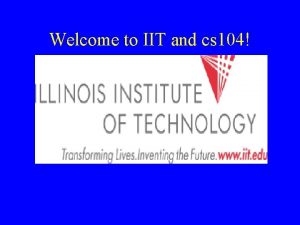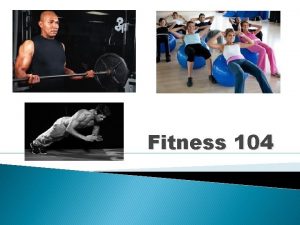Modern Physics ZCT 104 E3 Lecturer in charge































- Slides: 31

Modern Physics ZCT 104 E/3

Lecturer in charge: Yoon Tiem Leong (袁添亮) Email: tlyoon@usm. my Room 115, School of Physics, USM, Tel: 653 3674

www. geocities. com/tlyoon Or www. fizik. usm. my/tlyoon/ teaching/ modernphysics. htm

Course Description ØPhysic after 1900 Øspecial theory of relativity, particle nature of light and wave nature of matter, introductory quantum theory of atoms and introductory quantum mechanics. ØTime Planning

Contact hours Maximum contact hours = (2 x 7) weeks x (3 x 50) mins/week = 35 hours (ideally, but practically the number of contact hours could be lesser due to holidays) Ø Out of the 42 classes scheduled, 4 will be allocated for tutorials Ø Estimated lecture hours 32

Topics to be covered -1 The program of physics 1 lecture 13 Nov 03 (Thu) 0 Special theory of Relativity 12 (or 10) lectures 14 Nov 03 (Frid) - 1 Some preliminary wave physics 2 lectures 2 Particle properties of radiation 5 lectures

3 Wave properties of particles 3 lectures 4 Introductory quantum mechanics 4 lectures 5 Atomic models 5 lectures Total = 32 (30) lectures (flexi)

Ø Problem Sets (tutorial): 4 sets, download them from the web Ø Exams: confirm) Two tests, x-hour final exam (yet to Grading Ø Grading will be weighted: Midterm tests + 1 computer-based test, both contribute 30%, while final exam will contribute 70% to the total weight.

Textbooks 1) Kenneth Kane, Modern Physics, John. Wiley & Sons, 2 nd edition (August 1995) (required) 2) Modern Physics (Saunders Golden Sunburst Series) International edition, by Raymond A. Serway, Clement J. Moses, Curt A. Moyer (required) (alternatively, volume two, physics for scientists and engineers by Raymond A. Serway, third edition, by the same publisher) 3) Introduction to the Structure of Matter: A Course in Modern Physics, by John J. Brehm (Author), William J. Mullin, John Wiley & Sons; (January 1989) (advanced)

4) Elementary Modern Physics, by Richard T. Widner and Robert L. Sells, Allyn and Bacon Inc. , third edition 5) Concepts of Modern Physics, Arthur Beiser, Mc. Graw-Hill; 6 th edition 6) Physics, Cutnell and Johnson, John Wiley & Sons (International Edition), 6 th edition (simple)

7) Quantum Physics of Atoms, Molecules, Solids, Nuclei, and Particles by Robert Eisberg, Robert Resnick, John Wiley & Sons; 2 nd edition 7) 8) Introduction to special relativity, by Robert Resnick, John Wiley & sons

Course requirement (informal): Ø The students must be familiar with basic knowledge in some necessary mathematical tools such as calculus, differential equations, Taylor and/or binomial expansion Ø The students must have already equipped with fundamental knowledge in Newtonian mechanics Ø English

MAILING LIST Everyone must send an email to tlyoon@usm. my so that I could maintain a list of contact Type your name in the “Subject” Those who fail to do so have to bear the responsibility if any information pertaining to the lectures, e. g extra classes, change of venue and timetable etc. , fail to reach him/her

Downloads Ø Ø http: //www. geocities. com/tl yoon/calander. htm Password for lecture notes: 011103 (the date AB took over as PM) Ø Tutorial sets

Ø Consultation hours - anytime (but please call first) General Comments Ø intellectually intriguing and somewhat counter-intuitive, must prepare to think logically like Einstein. Ø Learn the methodology of doing ‘real’ physics Ø

Ø No ‘hafalan’ will work here – understanding is absolutely mandatory Ø Interactive learning is strongly encouraged – emailing, Q&A on class, in private, by phone, chat room on the web etc. Ø Your feedback to improve the quality of the lectures is welcomed Ø Must read text – lecture note is not enough

1 st lecture: The program of Physics Ø The program of physics is to devise concepts and laws that can help understand the physical universe. Ø A law in physics is a precise mathematical statement of a relation that has been found by repeated experiment to hold among physical quantities and that reflects persistent regularities in the behaviour of the physical world.


"good" physical laws Ø generality, simplicity, precision, fit experimental observations (e. g. Newtonian Physics) Ø New physics supplants old physics beyond the domain of validity of old physics (e. g. Special relativity vs. Newtonian Physics)


Ø The limits of physical theories: classical physics, quantum physics, special theory of relativity, relativistic quantum mechanics (QFT), general theory of relativity, statistical physics Ø Quantum gravity

Classical physics = physics before 1900 – thermodynamics, EM, classical mechanics Ø modern physics = the physics of the twentieth century (after 1900) Ø This course is about Quantum physics - atomic and nuclear structure, and Ø special theory of relativity – speed approaching that of light Ø failure of classical physics gives rise to modern physics Ø

The 'architects' of modern physics

From specific to general Usually we start from some known but specific theory and try to generalise it Ø a new (general) theory will yield the old (restricted) theory as a special approximation Ø E. g. when backtracking to your younger age, the difficult math you learnt in the University must reduce to that of simple arithmetic knowledge that you learnt in primary school Ø E. g. the relativity and quantum theories must yield classical physics when applied to largescale objects moving at speeds much lower than the speed of light Ø

The correspondence principle Ø Extrapolation from known physics to more general physics requires some “criteria” that must be fulfilled by the `new theory’ Ø Any new theory in physics, whatever its character or details, must reduce to the well established classical theory to which it corresponds when it is applied under the circumstances in which the less general theory is known to hold.

Example Special case: The parabola motion of projectile on Earth is a special case of the more general case of elliptic motion of satellite around the Earth Ø General case: The mathematical description of satellite has to reduce to parabolic motion of projectile on Earth surface when the length scale reduces from that of Earth size (~6000 km) to that of a short distance (say, ~ 100 m) Ø

Another example Ray optics and wave optics, both describing the propagation of light Ø Geometrical optics: only rectilinear propagation, reflection, refraction, valid only when l /d -> 0 Ø wave (physical) optics - more general (diffraction, interference, also rectilinear propagation), more comprehensive, valid up to l d Ø Limit (wave optics) = ray optics l /d 0 (no wave phenomena)


YOU MIGHT BE A PHYSICS MAJOR. . . if you have no life - and you can PROVE it mathematically. if you enjoy pain. if you know vector calculus but you can't remember how to do long division. if you chuckle whenever anyone says 'centrifugal force. ' if you've actually used every single function on your scientific calculator.

if you always do homework on Friday and Saturday nights. if you know how to integrate a chicken and can take the derivative of water. if you hesitate to look at something because you don't want to break down its wave function. if you have a pet named after a scientist. if you laugh at jokes about mathematicians. if the Humane society has you arrested because you actually performed the Schrodinger's Cat experiment.

if you avoid doing anything because you don't want to contribute to the eventual heat-death of the universe. if you consider ANY non-science course 'easy. ' if the 'fun' centre of your brain has deteriorated from lack of use. if you'll assume that a 'horse' is a 'sphere' in order to make the math easier. if you understood more than five of these indicators. if you make a hard copy of this list, and post it on your door. If these indicators apply to you, there is good reason to suspect that you might be classified as a physics major. I hope this clears up any confusion
 Lecturer's name
Lecturer's name Zpd zct
Zpd zct Lecturer in charge
Lecturer in charge Lecturer in charge
Lecturer in charge Why does it happen
Why does it happen University physics with modern physics fifteenth edition
University physics with modern physics fifteenth edition Physician associate lecturer
Physician associate lecturer Spe distinguished lecturer
Spe distinguished lecturer Teacher good morning class
Teacher good morning class Photography lecturer
Photography lecturer Designation lecturer
Designation lecturer Designation of lecturer
Designation of lecturer Gcwak
Gcwak Lecturer name
Lecturer name Pearson lecturer resources
Pearson lecturer resources 140000/120
140000/120 Lector vs lecturer
Lector vs lecturer Cfa lecturer handbook
Cfa lecturer handbook Lecturer asad ali
Lecturer asad ali Difference between charge and electric charge
Difference between charge and electric charge Difference between static and current electricity
Difference between static and current electricity Purdue phys 272
Purdue phys 272 Review of modern physics
Review of modern physics Modern physics means
Modern physics means Mark thomson particle physics
Mark thomson particle physics Modern physics introduction
Modern physics introduction Modern physics introduction
Modern physics introduction Modern physics introduction
Modern physics introduction Banked curve
Banked curve Physics
Physics Cmsc 104 umbc
Cmsc 104 umbc Programa 104
Programa 104





















